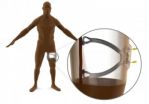(Press-News.org) This release is available in French.
Montreal, June 28, 2011 —Canadians aren't the only people concerned with weather, eh? A new study from McGill and Concordia universities observed pedestrians in nine cities around the world and found people are less likely to walk when temperatures dip below zero, when there's too much rain or too much snow. Published in the journal Environment and Behavior, the study was conducted over 170 days from late fall to early summer.
"A 5 degree Celsius increase in temperature was associated with a 14 per cent increase in pedestrians," says first author Luc de Montigny, a Concordia alumnus (BA 1995) and currently a post-doctoral fellow in the Department of Epidemiology, Biostatistics and Occupational Health at McGill University. "A shift from snow to dry conditions was associated with an increase of 23 per cent in pedestrian traffic."
Nine cities, with populations ranging from 18,000 to 1.2 million inhabitants, were observed: Santa Cruz in the Canary Islands; Kilmarnock and Glasgow in Scotland; Rousse in Bulgaria; Gliwice in Poland Oulu and Jakobstad in Finland; Sion in Switzerland; and Ithaca in the United States. From November through May, pedestrian traffic was observed between 7 a.m. and 5 p.m.
"All cities observed in our study were part of the northern hemisphere and in temperate climate zones," says senior author John Zacharias, a professor in the Department of Geography, Planning and Environment at Concordia University. "Yet the cities also feature quite different local weather conditions, from snowy, wintery conditions in Oulu to quite balmy year-round conditions in the Canary Islands."
Temperatures in the Canary Islands rarely fell below 15 degrees Celsius, while Oulu was found to be the coldest location with an average temperature below zero. Days of precipitation varied considerably among locations, with Kilmarnock and Glasgow having about five times as many rainy days as Sion or Ithaca.
"Precipitation had by far the largest effect on walking levels. The largest decrease was seen in Rousse, where walkers decreased by 42 per cent," says Zacharias, noting the most cities experienced an average 32 per cent decrease in walking during rainy or snowy days. "Conversely, there is a substantial and significant rise in pedestrian flow when it's not raining or snowing. A 5 per cent increase in sunlight was associated with a 2 per cent increase in walkers."
"Low air temperature had a much smaller impact on walking rates than might be supposed for temperate and Nordic cities," adds de Montigny.
A walk with Big Brother?
Data was collected using fixed, close-circuit cameras zeroed onto public plazas, squares and parks. While pedestrians didn't necessarily know they were being recorded, de Montigny stresses all security cameras are public and can be accessed via Google: "Low camera resolution, as well as distance from pedestrians, means pedestrian anonymity was preserved."
The authors state more people would walk if urban planners would design neighbourhoods that temper climatic extremes and use surfaces that are conducive to walking. Prompt snow removal and efficient drainage would also encourage pedestrian traffic.
"Given how obesity is increasingly affecting populations around the world, our study provides insight that shows people do walk when prepared for the weather," says de Montigny. "Walking really doesn't require big lifestyle changes and can be facilitated when walking conditions are optimal."
INFORMATION:
About the study:
The paper, "The Effects of Weather on Walking Rates in Nine Cities," published in the journal Environment and Behavior, was coauthored by Luc de Montigny of McGill University and Richard Ling and John Zacharias of Concordia University.
Related links:
Cited research: http://eab.sagepub.com/content/early/2011/05/19/0013916511409033
Concordia University: www.concordia.ca
McGill University: www.mcgill.ca
Source:
Sylvain-Jacques Desjardins
Senior advisor, external communications
Concordia University
Phone: 514-848-2424, ext. 5068
Email: s-j.desjardins@concordia.ca
Twitter: http://twitter.com/concordianews
Concordia news: http://now.concordia.ca
END
The Eatery on Beach Street has a new look on the inside and new menu items like Burger Diane and weekly specials like Friday's steak gone wild. The restaurant even has a new logo featuring a wine glass and new tagline.
The new logo and the new look are part of the restaurant's effort to attract a clientele that likes made-from-scratch American food with fresh ingredients and a creative twist.
"Chef Don likes to surprise patrons with a dish that mixes unexpected flavors or recreates a favorite recipe in a new form," said co-owner Cindy Gifford. She mentioned ...
New research confirms that a variant on the patatin-like phospholipase-3 (PNPLA3) gene increases risk of steatosis and fibrosis progression in patients with chronic hepatitis C virus (HCV). The PNPLA3 single nucleotide polymorphism (SNP) rs 738409 may represent an important genetic predictor and potential therapeutic target in chronic HCV liver damage. Study details are published in the July issue of Hepatology, a peer-reviewed journal of the American Association for the Study of Liver Diseases.
According to a report by the World Health Organization (WHO) roughly 170,000 ...
Bird species in rainforest fragments in Brazil that were isolated by deforestation disappeared then reappeared over a quarter-century, according to research results published today in the journal PLoS ONE.
Scientists thought many of the birds had gone extinct.
The research was funded by the National Science Foundation (NSF), and conducted in cooperation with Projeto Dinâmica Biológica de Fragmentos Florestais, Instituto Nacional de Pesquisas da Amazônia and the Smithsonian Tropical Research Institute in Manaus, Brazil.
Lead author Philip Stouffer, an ornithologist ...
From educators to leaders in industry, there is broad agreement that U.S. schools have a crucial challenge in improving teaching and learning in science, technology, engineering and math (STEM) among students from kindergarten through high school. A background in STEM is not only essential to many current and future careers; it is also a means for citizens to understand and participate in an increasingly complex world--from understanding the challenges of environmental sustainability to addressing the need for alternative sources of energy.
The NRC report, "Successful ...
New research by the University of Warwick and Humboldt university shows that the frequency of wars between states increased steadily from 1870 to 2001 by 2% a year on average. The research argues that conflict is being fed by economic growth and the proliferation of new borders.
We may think the world enjoyed periods of relative freedom from war between the Cold War and 9/1 but the new research by Professor Mark Harrison from at the University of Warwick's the Centre for Competitive Advantage in the Global Economy, and Professor Nikolaus Wolf from Humboldt University, ...
When Oxygen4Energy Athlete Kellie Wells got to Eugene, Oregon this past week, she had only one thing on her mind... winning a national championship. She knew that all of the nation's top competitors would also be there gunning for the title, but she was definitely up for the challenge.
So far this year, Kellie has been the most dominant figure in women's hurdles by tying an American Record (55m Hurdles), winning the Indoor National Title, running multiple World Lead times, winning the first Diamond League event, and never finishing worse than 2nd place in any race she ...
The global economic recession of 2008-09 has been followed by a decline in fertility rates in Europe and the United States, bringing to an end the first concerted rise in fertility rates in the developed world since the 1960s, according to research published today.
"In a new study, scientists from the Vienna Institute of Demography of the Austrian Academy of Sciences (VID) and the International Institute for Applied Systems Analysis (IIASA) identify that economic recessions tend to be followed by a decline in fertility rates - and also identify how specific groups of ...
Johns Hopkins University graduate students have invented a device to reduce the risk of infection, clotting and narrowing of the blood vessels in patients who need blood-cleansing dialysis because of kidney failure.
The device, designed to be implanted under the skin in a patient's leg, would give a technician easy access to the patient's bloodstream and could be easily opened and closed at the beginning and end of a dialysis procedure.
The prototype has not yet been used in human patients, but testing in animals has begun.
The students learned about the need for ...
Zinger Digital Signs today introduced eight new free-standing digital poster kiosk solutions for the retail and office/corporate markets. The digital signage poster kiosks are aimed at replacing printed posters used in retail and corporate environments. The new digital poster kiosks are certified for true 24/7 operations in commercial applications.
Digital posters offer many benefits to printed posters including savings from printing, shipping & handling. Digital posters can be updated instantly, giving retailers a tremendous benefit for those last minute sales or ...
A new, cost-effective process for colouring titanium can be used in manufacturing products from sporting equipment to colour-coded nuclear waste containers.
"The new method uses an electrochemical solution to produce coloured titanium, improving on an older, time-consuming and expensive method where heat was used to develop a coloured layer," says Gregory Jerkiewicz, a professor in the Department of Chemistry.
Dr. Jerkiewicz's new technique can be finely tuned to produce over 80 different shades of basic colours. In addition, the coloured titanium produced using the ...





